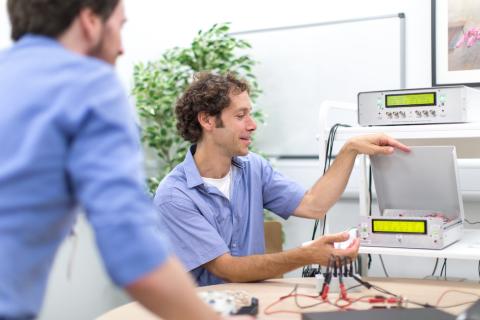Scientists led by Dr Nir Grossman (UK DRI at Imperial) have been able to pinpoint, for the first time, the exact moment the brain transitions into sleep, and precisely map the unfolding process in real time. The findings, published in Nature Neuroscience, could be used to develop new ways to diagnose and treat sleep disorders, such as insomnia, and as a marker of brain health in the context of ageing and neurodegenerative disease, and even to improve how we monitor anaesthesia during surgical procedures.
In the new study, the researchers demonstrated that the human brain falls asleep abruptly, rather than gradually, with a ‘tipping point’ marking the transition from wakefulness into sleep. They were then able to predict the momentary progression into sleep with unprecedented precision.
Previous definitions of sleep onset have relied on subjective, discrete annotations of brain activity from EEG readings, or indirect measures such as heart rate, breathing rate, and movement. This new approach is the first time scientists have been able to objectively infer the precise momentary progression and exact point at which the brain falls asleep.
Led by the UK DRI at Imperial and the UK DRI Centre for Care Research & Technology at Surrey, the study analysed electroencephalogram (EEG) recordings taken from more than a thousand people who wore electrodes to record their brain activity during the night.
The researchers used a novel computational method that represented the changes in the brain as movement in a multi-dimensional space (called a feature space), and mapped out how each individual moved from bedtime toward sleep.
They found that no matter how long participants were in bed, the transition from wakefulness to sleep occurred abruptly in the final few minutes at a clear tipping point. Such a dynamic is known as a ‘bifurcation’, another example of which is the gradual bending of a stick until it eventually snaps. It also resembles the movement of a falling object, thereby supporting the subjective sensation of ‘falling asleep’.
Sleep is a fundamental part of our lives. The process of falling asleep is the critical gateway to the vital physiological and cognitive benefits of sleep. Yet, how our brain falls asleep has been one of the most enduring mysteries of neuroscience.
In this study, we presented a method that enables us, for the first time, to track in real-time how the brain transitions into sleep with unprecedented precision. We discovered that falling asleep is a bifurcation, not a gradual process, with a clear tipping point that can be predicted in real time.
Group Leader
In a different experiment, involving recording over multiple nights, they discovered that each participant had a unique location (in the multi-dimensional space) at which sleep began, which was consistent across multiple nights of sleep.
Armed with this discovery and the bifurcation model, the researchers showed that they could predict with 98% accuracy the exact progression (second-by-second) by which each participant fell asleep.
Study leader Dr Nir Grossman, Group Leader at the UK Dementia Research Institute at Imperial College London, said:
“Sleep is a fundamental part of our lives. The process of falling asleep is the critical gateway to the vital physiological and cognitive benefits of sleep. Yet, how our brain falls asleep has been one of the most enduring mysteries of neuroscience.
In this study, we presented a method that enables us, for the first time, to track in real-time how the brain transitions into sleep with unprecedented precision. We discovered that falling asleep is a bifurcation, not a gradual process, with a clear tipping point that can be predicted in real time.
The ability to track how individual brains fall asleep has profound implications for our understanding of the sleep process. It also serves as a vital health marker for changes in the brain, due to factors such as ageing or the development of brain diseases like dementia. Importantly, it could facilitate the development of new treatments for people who struggle with falling asleep.”
Senior co-author Professor Derk-Jan Dijk, Group Leader at the UK Dementia Research Institute Centre for Care Research and Technology at Imperial College London and the Unversity of Surrey, said:
“Our experiments demonstrate that by analysing brain waves through a ‘dynamical system’ lens, we can generate new insights into how sleep really works, going far beyond what standard sleep scoring reveals.
This study has the potential to transform how we clinically define the beginning of sleep. It is commonly believed that falling asleep is a gradual, continuous process, but we have identified that it is in fact an abrupt transition, with a tipping point at which the brain moves from a waking state into sleep. Understanding and harnessing this will enable us to better study the biology underpinning the process of falling asleep, and inform the development of new diagnostic tools and therapies.”
Dr Karen Brakspear, Head of Neurosciences and Mental Health at the Medical Research Council, said:
“Sleep disturbances are increasingly recognised as a risk factor for neurodegenerative disease such as Alzheimer’s disease.
By better understanding the brain’s transition into sleep, we can begin to unravel the complex links between sleep and dementia and potentially develop new strategies to promote healthy sleep.”
This study was funded by the UK Dementia Research Institute, which is principally funded by the Medical Research Council.

